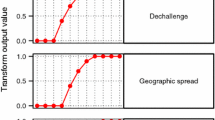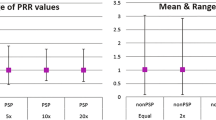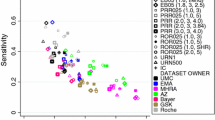Abstract
Background: Screening large databases of spontaneous case reports of possible adverse drug reactions (ADRs) is an established method of identifying hitherto unknown adverse effects of medicinal products; however, there is a lack of consensus concerning the value of formal statistical screening procedures in guiding such a process. This study was performed to clarify the nature of any added benefits and additional effort required when established pharmacovigilance techniques are supplemented with statistical screening.
Objective: To evaluate whether statistical signal detection in spontaneous reporting data can lead to earlier detection of drug safety problems and to assess the additional regulatory work entailed.
Methods: Using the EudraVigilance post-authorization module (EVPM), a screening procedure based on the proportional reporting ratio (PRR) was applied retrospectively to examine if regulatory investigations concerning ADRs in a predefined set of products could have been initiated earlier than occurred in practice. During the same time period, between September 2003 and March 2007, the number of PRR-based signals of disproportionate reporting (SDR) that arose in the same set of products was calculated and evaluated to determine the number requiring investigation. The outcome is expressed as the ratio of the number of SDRs requiring investigation compared with the number of signals pre-empted by the statistical screening approach. In those cases where the signal was discovered earlier, the delay was calculated between identification by the PRR method and by the method that originally identified the signal.
Results: In 191 chemically different products, 532 adverse reactions were added to the summary of product characteristics during the study period. Of these, 405 were designated as important medical events (IMEs) based on a comprehensive predefined list. Of the IMEs, 217 (53.6%) were identified earlier by the statistical screening technique, 79 (19.6%) were detected after the date at which they were raised by standard pharmacovigilance methods and 109 (26.9%) were not signalled during the study period. 1561 SDRs requiring further evaluation were detected during the study period, giving a ratio of 7.2 assessments for each signal pre-empted. The mean delay between the discovery of signals using the statistical methods in the EVPM and established methods in the 217 cases detected earlier was 2.45 years. A review resulted in clear explanation for why the statistical method had not preempted detection in all but 77 of 188 cases.
Conclusions: The form of statistical signal detection tested in this study can provide significant early warning in a large proportion of drug safety problems; however, it cannot detect all safety issues more quickly than other pharmacovigilance processes and hence it should be used in addition to, rather than as an alternative to, established methods.










Similar content being viewed by others
Notes
1 MedDRA®terminology is the international medical terminology developed under the auspices of the International Conference on Harmonization (ICH) of Technical Requirements for Registration of Pharmaceuticals for Human Use.
2 This is explained by the fact that some Marketing Authorization Holders have submitted several applications (under different invented names) for the same molecule or active substance (i.e. multiple applications).
References
The rules governing medicinal products in the European Union. Notice to applicants and regulatory guidelines for medicinal products for human use. Vol. 2 [online]. Available from URL: http://ec.europa.eu/enterprise/sectors/pharmaceuticals/documents/eudralex/vol-2/index_en.htm [Accessed 2010 Apr 13]
The rules governing medicinal products in the European Union. Guidelines on pharmacovigilance for medicinal products in human use. Vol. 9A [online]. Available from URL: http://ec.europa.eu/enterprise/pharmaceuticals/eudralex/vol-9/pdf/vol9a_09-2008.pdf [Accessed 2010 Apr 13]
VanPuijenbroek E, Bate A, Leufkens HGM, et al. A comparison of measures of disproportionality for signal detection in spontaneous reporting systems for adverse drug reactions. Pharmacoepidemiol Drug Saf 2002; 11: 3–10
European Medicines Agency. Eudra Vigilance: pharmacovigilance in the European economic area [online]. Available from URL: http://eudravigilance.emea.europa.eu/highres.htm [Accessed 2010 Apr 13]
Council regulation (EEC) no. 2309/93 of 22 July 1993 laying down community procedures for the authorization and supervision of medicinal products for human and veterinary use and establishing a European agency for the evaluation of medicinal products [online]. Available from URL: http://ec.europa.eu/enterprise/pharmaceuticals/eudralex/vol-1/reg_1993_2309/reg_1993_2309_en.pdf [Accessed 2010 Apr 13]
Evans SJW, Waller P, Davis S. Use of proportional reporting ratios (PRR) for signal generation from spontaneous adverse drug reaction reports. Pharmacoepidemiol Drug Saf 2001; 10:483–6
European Medicines Agency, EudraVigilance Expert Working Group. Guideline on the use of statistical signal detection methods in the EudraVigilance data analysis system (EMEA/106464/2006 rev.1) [online]. Available from URL: http://www.emea.europa.eu/pdfs/human/phvwp/10646406enfin.pdf [Accessed 2010 Apr 13]
MedDRA MSSO [online]. Available from URL: http://www.meddramsso.com [Accessed 2010 Apr 13]
Hochberg AM, Reisinger SJ, Pearson RK, et al. Using data mining to predict safety actions from FDA Adverse Event Reporting System data. Drug Inf J 2007; 41: 633–43
Almenoff J, Tonning JM, Gould AL, et al. Perspectives on the use of data mining in pharmacovigilance. Drug Saf 2005; 28(11): 981–1007
Acknowledgements
This study was requested by the EudraVigilance Steering Committee and we would like to thank N. Wathion, P. Arlett, S. Brosch, H-G. Eichler and X. Kurz for their constructive comments.
The views expressed in this article are the personal views of the authors and may not be understood or quoted as being made on behalf of or reflecting the position of the EMA or one of its committees or working parties. The EMA does not profit financially from EudraVigilance or associated signal detection activities. None of the authors have any conflicts of interest to declare.
Author information
Authors and Affiliations
Corresponding author
Rights and permissions
About this article
Cite this article
Alvarez, Y., Hidalgo, A., Maignen, F. et al. Validation of Statistical Signal Detection Procedures in EudraVigilance Post-Authorization Data. Drug-Safety 33, 475–487 (2010). https://doi.org/10.2165/11534410-000000000-00000
Published:
Issue Date:
DOI: https://doi.org/10.2165/11534410-000000000-00000




